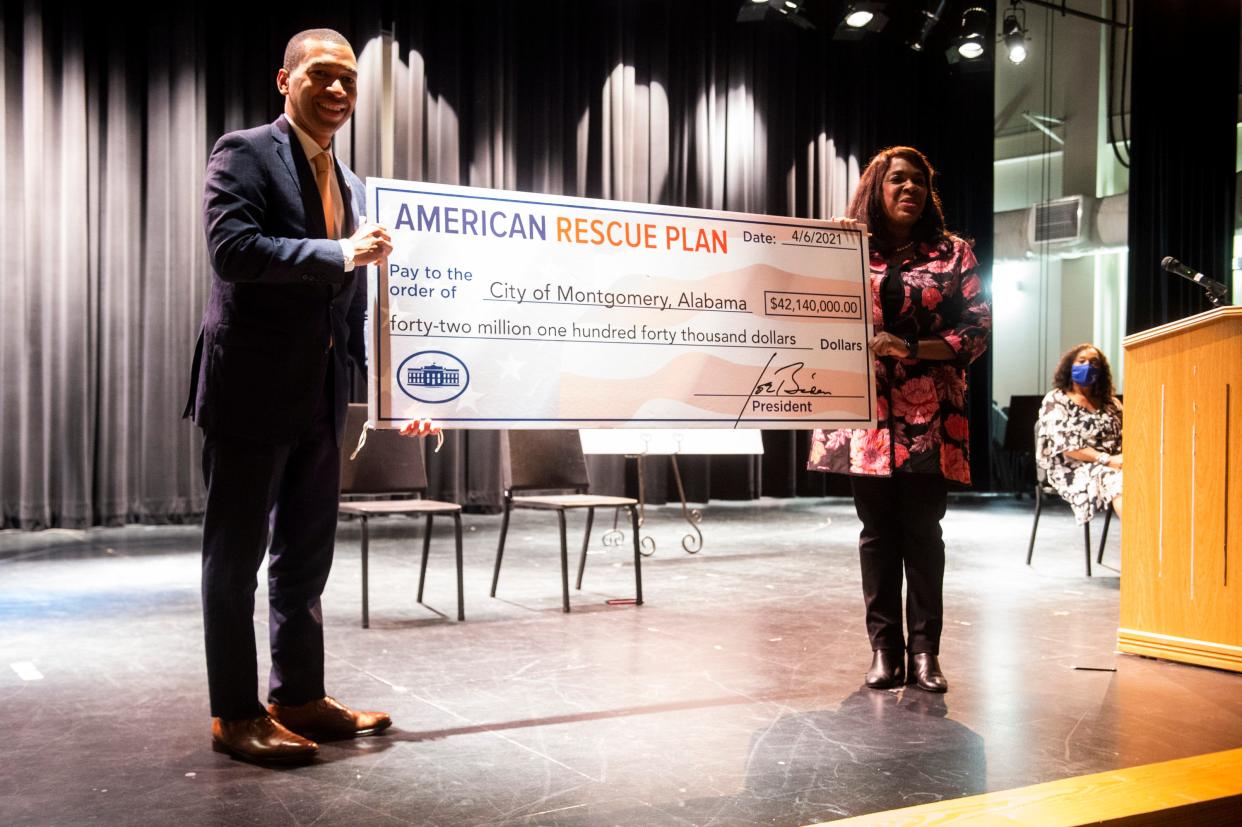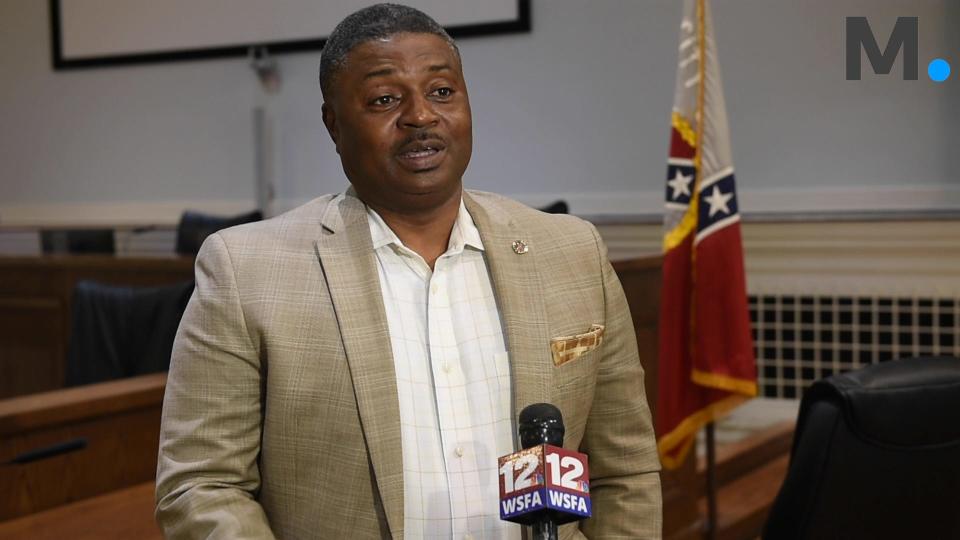Where's Montgomery's American Rescue Plan money? Council trying to figure out how to spend it

The City of Montgomery has yet to decide how it will spend its federal coronavirus relief money, and confusion between members of the Montgomery City Council makes it unclear when the body will reach a consensus.
At its most recent meeting on June 7, Montgomery City Council voted against a resolution detailing how the city would spend $12.7 million of the $41.6 million allocated to it from the American Rescue Plan Act, signed into law by President Joe Biden in March 2021. The resolution proposed to fund capital improvements for a mental health crisis center, body camera improvements for the Montgomery Police Department and a comprehensive review of sewer issues in the city, among other things.
When the item came before the Council during their June 7 meeting, Councilor CC Calhoun, the resolution’s sponsor, asked the council to take a vote. The vote on the resolution was postponed at the last meeting in May, and Calhoun said he heard that councilors wanted to carry the item over to the next meeting on June 21.

“I hadn’t heard any talk back over the last three weeks about any concerns about what we discussed,” Calhoun said at the meeting. “I just don’t see why we should carry over a resolution for another two weeks before we call for a vote.”
The resolution proposed for the city to spend up to $12.7 million split between the following six projects, with funding allocations in parentheses:
Capital improvements to the Montgomery Mental Health Authority’s Crisis Diversion Center (up to $2.43 million)
Hospital/community-based violence intervention programming (up to $973,000)
Body camera upgrades for the Montgomery Police Department (up to $1.5 million)
Small business and entrepreneurship programming (up to $2.43 million)
A blighted property buyback program (up to $2.43 million)
A comprehensive countywide review of sewer issues (up to $2.92 million)
The council voted against the resolution 5-3, with Councilors Calhoun, Marche Johnson and Oronde K. Mitchell voting in favor.
After the meeting, those who voted against the resolution voiced similar concerns to those they had at the May 17 meeting. Most of the conflict over the resolution boils down to this: The council can’t seem to agree on what the council agreed to pay for.
The Montgomery City Council and Montgomery County Commission created Montgomery Thrive in November 2021 to pool the city's and county’s ARPA funds and spend them collaboratively on projects affecting Montgomery residents.
At the most recent Montgomery Thrive meeting on April 25, the group – composed of the county’s four commissioners, nine city councilors and Mayor Steven Reed – discussed five priorities for funding, according to a meeting agenda Calhoun shared with the Advertiser.
Those five items were all on the resolution before the Council on May 17 and June 7. Additional body camera technology for MPD was not listed on the Montgomery Thrive agenda, but several councilors and Commission Chairman Doug Singleton said body cameras had been discussed at Montgomery Thrive meetings and most members were in favor of funding them.
Councilor Ed Grimes said that the council and commission had only agreed to fund three of those items: the crisis center improvements, body cameras and the sewer study.
“We came in with like three additional items — items that we had not thoroughly discussed,” Grimes said. “Now, I'm not saying that we won't do those things. We just haven't really talked through those.”
Singleton corroborated Grimes’ claim that only three items had been fully agreed upon at the Montgomery Thrive meeting. But the county commission only approved two of the items at its May 17 meeting, and Councilor Glen Pruitt said he wants to make sure the city is staying on the same page as the county so that together, they can “get the most bang for their buck.”
Councilor Audrey Graham, on the other hand, said she objected to the resolution because she felt that the last project — nearly $3 million for a study on sewer issues in the county — was superfluous. The city already knows what the issues are, and now it’s time to take action to fix them, she argued.
Others on the council, though, say that the city won’t know how to best address those problems without doing a study. The $2.92 million is also an upper bound on spending, and the city likely won’t spend it all on the study, Calhoun said.
Calhoun said the issues could have been addressed in the three weeks that passed since the resolution originally appeared before the council. Even before the council's May 17 meeting, Reed said that councilors had access to a draft of the resolution.
“I don’t know if there are any surprises in [the resolution]. I don’t know if people didn’t read the draft, but this is what has been out there for at least over a month,” Reed said at the May 17 council meeting. “In our prior meetings I would have thought that if there was any question about being able to implement this before the second round of funding was released to the state and the city, those questions may have been brought up then.”
![“I don’t know if there are any surprises in [the resolution]. I don’t know if people didn’t read the draft, but this is what has been out there for at least over a month,” Mayor Steven Reed said.](https://s.yimg.com/ny/api/res/1.2/BXvpBmCe6OqLp2C3jx8SyA--/YXBwaWQ9aGlnaGxhbmRlcjt3PTk2MDtoPTY4Mg--/https://media.zenfs.com/en/the-montgomery-advertiser/034c0f4b47657bd73bd95a6cce77a191)
Johnson, who voted in favor of the resolution, said that the delay in allocating the funding has gotten to a point where “it’s almost offensive.”
“We've all had our input. It should be a no brainer,” she said. “But at this point, it seems as if — I don't know. I really don't know where it's going at this point.”
The City Council and County Commission are holding the next Montgomery Thrive meeting on Monday at 4 p.m. at the County Commission building. Calhoun said he hopes that the group addresses all the concerns held by its members and leaves that meeting prepared to spend the money.
“I think we can stop playing politics and just go ahead and do what we need to do for the betterment of the citizens of Montgomery, because we have the money,” he said. “We need to be more aggressive on how we spend it and do the things that's going to impact our citizens and our constituent base and move forward.”
In its current form, the resolution allocates only about a quarter of the city’s relief dollars, and the city and county have until the end of 2024 to decide how they will spend the ARPA funds.
Calhoun encouraged residents to stay involved as the city council decides how — and when — the money should be spent.
“You have to, you know, continue to be involved in the process. Put pressure on the elected leadership,” Calhoun said.
Evan Mealins is the justice reporter for the Montgomery Advertiser. Contact him at emealins@gannett.com.
This article originally appeared on Montgomery Advertiser: Montgomery City Council unsure how to spend American Rescue Plan money

